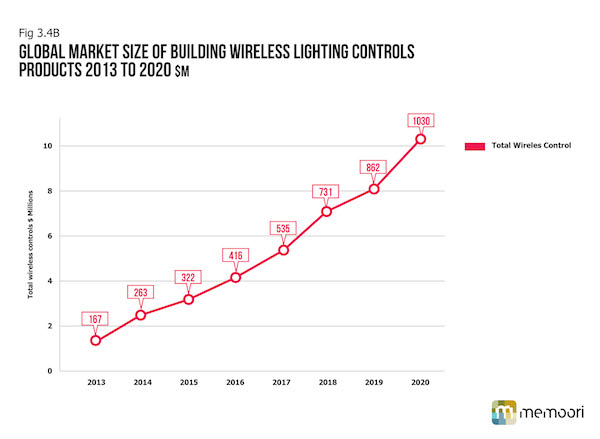|
August 2014
Article
AutomatedBuildings.com
|
[an error occurred while processing this directive]
(Click
Message to Learn More)
|
|
Sizing the Smart Wireless Lighting Controls Market
& Growth to 2018
LED will be dependent
upon smart wireless controls, if it is to open up the vast retrofit
market in the commercial and industrial building space.
|

Allan McHale,
Director,
Memoori
|
Not surprisingly the introduction of LED Lighting has given a major
boost to smart lighting controls right across the globe; but we are now
entering a new phase of its development, when LED will be dependent
upon smart wireless controls, if it is to open up the vast retrofit
market in the commercial and industrial building space.
The LED lighting companies will soon need this business. LED is not
creating a new market but is replacing an existing one and
progressively each year it loses the conventional bulb replacement
business, which was (and still is for the time being) a cash cow. LEDs
last for the lifetime of the fittings, which means little possibility
of regular revenues. Therefore they will need to open up the retrofit
market; and they need wireless controls to enable this.
Memoori’s market research report “The Smart Wireless Controls Market
for Lighting 2014 – 2018” -
http://www.memoori.com/portfolio/smart-buildings-wireless-lighting-controls-2014-to-2018/
estimates the world value of smart lighting control product in 2013 at
$1.668 billion at factory gate prices and of this only 10% accounted
for wireless controls. We forecast that the global market for Lighting
Controls from 2013 to 2020 will grow at a CAGR of 12%. However wireless
controls will grow more rapidly and by 2020 will account for some 23%
of the smart lighting controls market. Wireless controls currently
provide the only means of delivering an acceptable return on the
building owner’s investment and that is the driving force because its
growth opens up the enormous technical latent potential for
retrofitting the vast building stock across the world. 
The report shows that although most of the wireless controls technology
has evolved in the developed countries of the world over the next 7
years growth in the developed markets of Europe and North America will
fall behind China an Asia where it will well exceed the average CAGR of
30% across the world.
These figures do not include any other controls or value add services
that could well become part of the lighting controls contract.
Developing countries, particularly China and Asia may take up the
initiative to go for wireless in new construct buildings where they see
it providing the platform for the Internet of Things (IoT). Resistance
to wireless control is a little more entrenched in the western world.
Looking back over the last seven years shows a volatile and disappointing
performance for the lighting controls business. From the liquidity
crisis in 2007 and the financial meltdown in 2008, trading conditions
have been very poor and particularly so in the commercial and
industrial building industry. Demand in new construction has since
picked up and therefore lighting and its control has seen an increase
in demand since 2010. At the same time the introduction of LED Lighting
has further increased demand and in order to deliver a low carbon
economy in the 21st century this growth has to be sustainable.
Our forecast for a CAGR of 30% for wireless controls is indeed a high
rate of growth particularly for a rather mature lighting business but
is still a relatively small percentage of the potential that is
currently available. The big major imponderable is when will the
retrofit market really kick in.
[an error occurred while processing this directive]
What is needed now is a major awareness campaign backed by government
agencies to target building owners on the benefits of LED Lighting and
its control. They are the ones that will have to make the investment
decision and therefore the case for doing so has to be centered on
what’s in it for them.
We have identified 20 companies that we believe have the products and
resources to grow this market at the rate we have forecast and more.
They have been taken from our listing of 121 lighting controls
companies so it’s very likely that there are more challengers out
there. The report also details how building the supply side through
M&A and Venture Capital is strengthening the business. Investors
are attracted to this market for its relatively low risk but high
growth prospects –
http://www.memoori.com/portfolio/smart-buildings-wireless-lighting-controls-2014-to-2018/
footer
[an error occurred while processing this directive]
[Click Banner To Learn More]
[Home Page] [The
Automator] [About] [Subscribe
] [Contact
Us]
